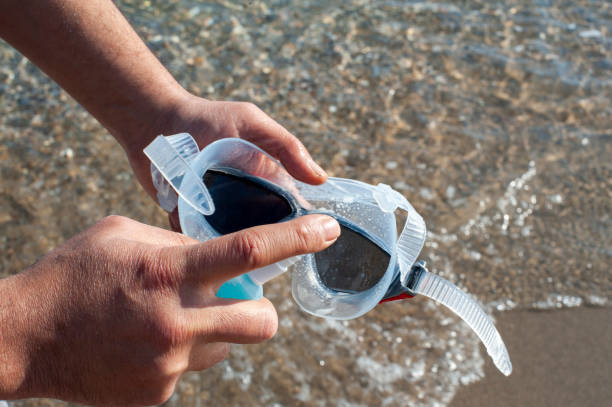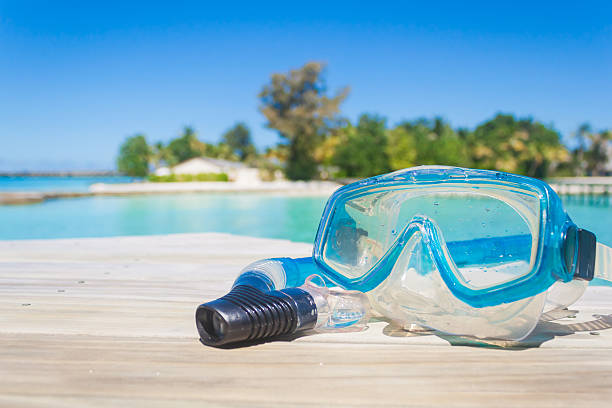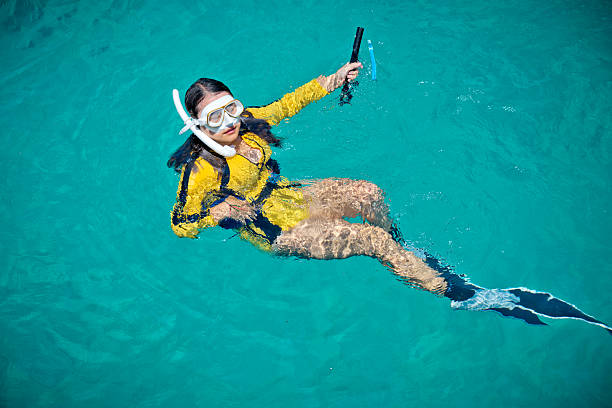L'oceano ospita una straordinaria varietà di vita marina, dai minuscoli cavallucci marini alle maestose tartarughe marine. Snorkeling, immersioni subacquee e apnea offrono l'opportunità di incontrare queste creature da vicino, coltivando un profondo apprezzamento per il delicato equilibrio degli ecosistemi marini. Ogni immersione è un'opportunità per ammirare in prima persona le meraviglie della natura. Che si tratti di scivolare senza sforzo in acque cristalline o di immergersi in profondità con un solo respiro, gli amanti dello snorkeling e dei subacquei assaporano l'emozione di esplorare territori inesplorati sotto le onde. Per approfondire le differenze tra snorkeling, immersioni subacquee e apnea, questo articolo ne illustrerà le caratteristiche, la profondità raggiungibile e altro ancora. Immergiamoci nel mondo sottomarino!
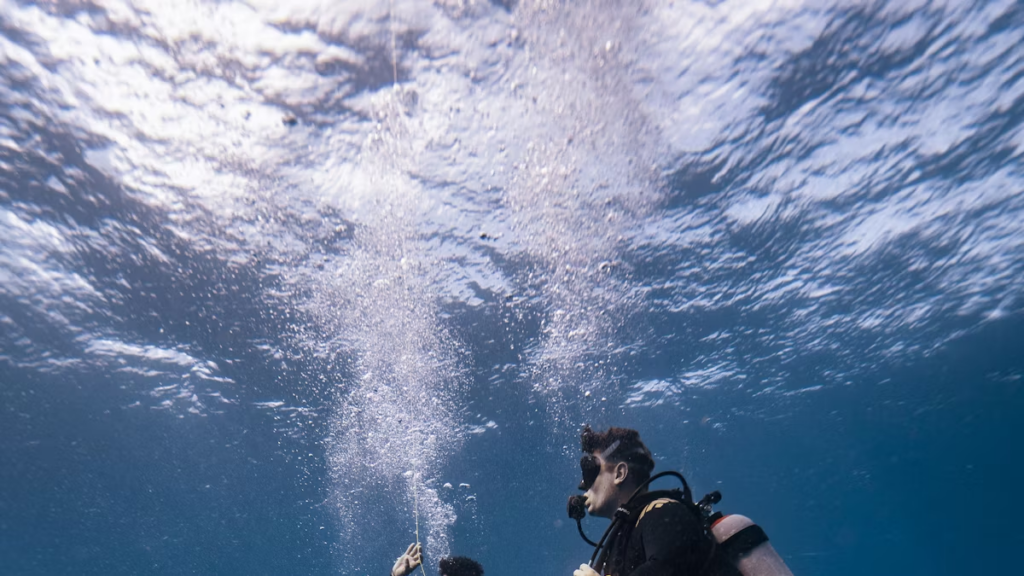
Che cos'è lo snorkeling?
Lo snorkeling è un'attività acquatica molto popolare che permette di esplorare il mondo sottomarino senza la necessità di un addestramento approfondito o di attrezzature specifiche. Si tratta di nuotare in superficie utilizzando un boccaglio per respirare e un paio di pinne per la propulsione. Questa forma accessibile di esplorazione subacquea è apprezzata da persone di tutte le età e livelli di abilità, rendendola una scelta privilegiata per il tempo libero e l'avventura.
Benefici dello snorkeling
- Attività fisica:Lo snorkeling è un ottimo allenamento a basso impatto, che coinvolge vari gruppi muscolari e favorisce la salute cardiovascolare.
- Accessibilità:A differenza delle immersioni subacquee, lo snorkeling non richiede un addestramento o una certificazione particolari, il che lo rende accessibile a un'ampia gamma di appassionati.
- Adatto alle famiglie:È un'attività che può essere praticata da tutta la famiglia poiché richiede un'attrezzatura e una competenza minime.
- Conveniente:Rispetto ad altre forme di immersione, lo snorkeling è relativamente conveniente poiché richiede un'attrezzatura minima.
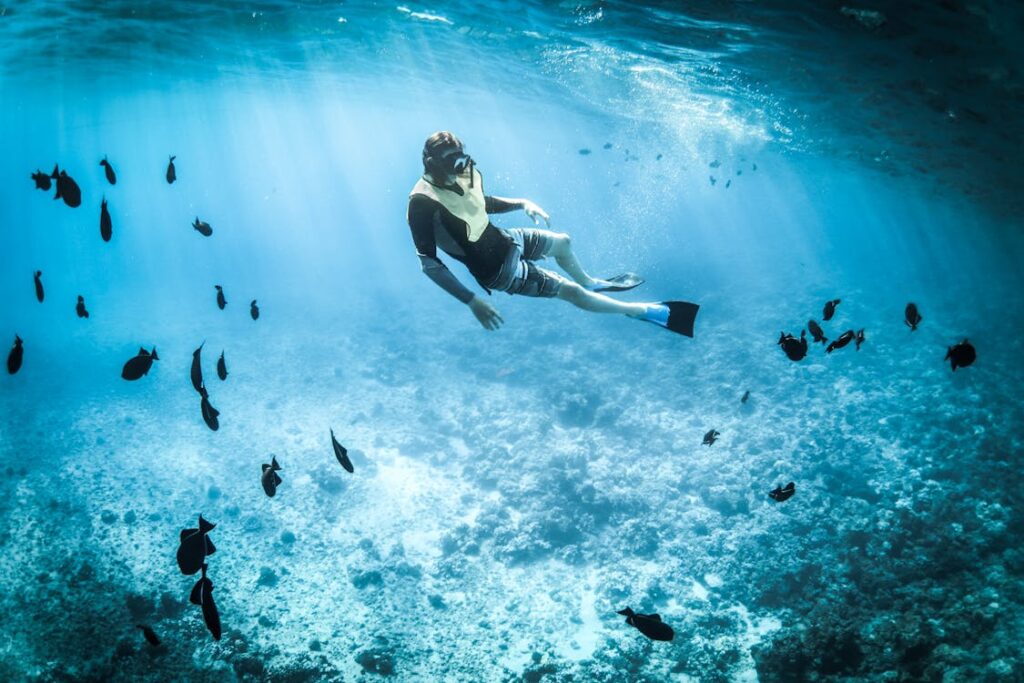
Quanto in profondità possono andare i subacquei che praticano lo snorkeling?
Gli amanti dello snorkeling sono generalmente limitati a profondità che vanno da 90 a 3 metri. Questa bassa profondità permette agli appassionati di osservare la vivace vita marina e gli splendidi paesaggi sottomarini rimanendo vicini alla superficie dell'acqua. La profondità limitata garantisce che le persone possano facilmente tornare in superficie per respirare senza bisogno di addestramento o attrezzature specifiche.
Suggerimenti per massimizzare la profondità dello snorkeling
Sebbene gli amanti dello snorkeling siano generalmente limitati alle acque poco profonde, esistono delle strategie per massimizzare la profondità a cui possono dedicarsi:
- Movimenti semplificati: Tecniche di nuoto efficienti possono aiutare a ridurre la resistenza e migliorare la propulsione, consentendo ai subacquei di coprire distanze maggiori risparmiando energia.
- Controllo corretto dell'assetto: Padroneggiare il controllo dell'assetto consente agli amanti dello snorkeling di mantenere una posizione comoda in acqua, facilitando movimenti più fluidi e risparmiando energia durante l'esplorazione.
- Tecniche di respirazione chiara:Esercitare una respirazione rilassata con lo snorkel garantisce un efficiente ricambio d'aria e favorisce la calma durante le escursioni subacquee.
- Utilizzo ottimale delle attrezzature:L'uso di pinne ben adattate che garantiscano un'adeguata propulsione può migliorare la manovrabilità in acque poco profonde, consentendo ai subacquei di navigare con facilità.
Di quale attrezzatura per lo snorkeling hai bisogno?
Quando ci si prepara per un fare snorkeling avventura, avendo il diritto attrezzatura per lo snorkeling È essenziale per garantire un'esperienza sicura e piacevole. La seguente attrezzatura è necessaria agli amanti dello snorkeling per esplorare l'affascinante mondo sottomarino.
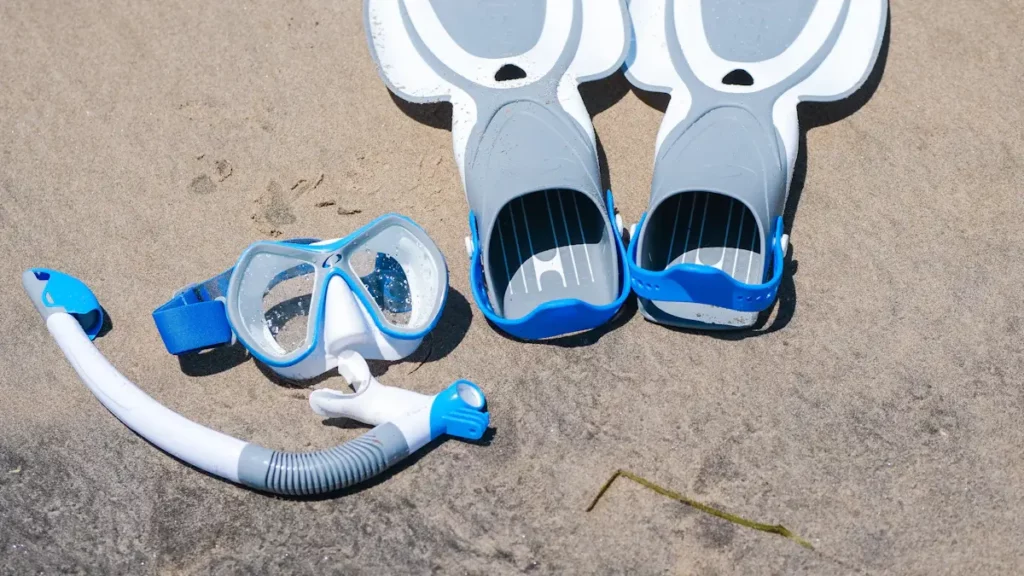
Maschera
Una maschera di alta qualità offre una visione chiara sott'acqua e garantisce una vestibilità comoda. La maschera crea una sacca d'aria intorno agli occhi, consentendo agli amanti dello snorkeling di vedere chiaramente e di impedire l'ingresso dell'acqua.
Fare snorkeling
Lo snorkel è un tubo che permette di respirare galleggiando a faccia in giù sulla superficie dell'acqua. In genere è costituito da un boccaglio, una canna e una valvola di spurgo per eliminare l'acqua che entra nel tubo.
Pinne
Le pinne sono essenziali per la propulsione e la manovrabilità in acqua, consentendo agli amanti dello snorkeling di navigare con facilità e risparmiare energia durante l'esplorazione. Sono disponibili in vari modelli, tra cui pinne a scarpetta intera e pinne con cinturino regolabile.
Muta o Rash Guard
A seconda del temperatura dell'acqua, indossando un muta o protezione anti-eruzione cutanea Può fornire protezione termica e schermare dall'esposizione al sole. Una muta offre isolamento intrappolando un sottile strato d'acqua tra la muta e la pelle, mantenendo gli amanti dello snorkeling al caldo nelle acque più fredde. In alternativa, una muta anti-urto (Right Guard) offre protezione UV e aiuta a prevenire le irritazioni dovute all'esposizione prolungata all'acqua salata.
Giubbotto da snorkeling
Un giubbotto da snorkeling aumenta la sicurezza offrendo ulteriore galleggiabilità agli amanti dello snorkeling, in particolare a coloro che hanno meno esperienza o sicurezza in acqua. Questo giubbotto gonfiabile può essere facilmente regolato per garantire il massimo comfort e offre sicurezza a chi desidera un supporto extra durante l'esplorazione di acque poco profonde.
Soluzione antiappannamento
UN soluzione antiappannamento applicato sulla superficie interna della maschera impedisce l'appannamento creando una sottile pellicola che distribuisce la condensa in modo uniforme sulla lente.
Fotocamera subacquea (opzionale)
Le fotocamere impermeabili progettate appositamente per lo snorkeling consentono agli appassionati di conservare le proprie esperienze e condividerle con altri.
Borsa a rete (opzionale)
UN borsa a rete È un modo pratico per trasportare l'attrezzatura da snorkeling da e verso la riva. Il suo design traspirante permette all'attrezzatura bagnata di asciugarsi naturalmente, evitando l'accumulo di sabbia all'interno della borsa. Inoltre, offre spazio per riporre oggetti personali come crema solare, occhiali da sole e snack.
Pro e contro dello snorkeling
Lo snorkeling offre una miriade di vantaggi, rendendolo un'attività interessante per chi desidera esplorare il mondo sottomarino. Tuttavia, come qualsiasi attività ricreativa, presenta anche alcuni svantaggi che gli appassionati dovrebbero considerare. Comprendere i pro e i contro dello snorkeling può aiutare a prendere decisioni consapevoli sulla partecipazione a questa esperienza immersiva.
Pro dello snorkeling
1. Accessibilità a tutti i livelli di abilità
Lo snorkeling è accessibile a persone di tutte le età e livelli di abilità, richiedendo un addestramento o una certificazione minimi. Questa inclusività lo rende un'attività ideale per famiglie, principianti ed esperti, promuovendo un senso di esplorazione e avventura condivisa.
2. Incontri immersivi con la vita marina
Dalle vivaci formazioni coralline ai banchi di pesci tropicali, gli amanti dello snorkeling possono ammirare scenari sottomarini incantevoli che offrono uno sguardo sugli intricati ecosistemi che prosperano sotto le onde.
3. Attività fisica a basso impatto
Praticare lo snorkeling è un'attività fisica a basso impatto che promuove la salute cardiovascolare e rafforza diversi gruppi muscolari. La delicata propulsione ottenuta con i movimenti delle pinne offre un allenamento piacevole, riducendo al minimo lo stress su articolazioni e muscoli.
4. Esplorazione conveniente
Rispetto ad altre forme di immersione, lo snorkeling è relativamente conveniente, poiché richiede un'attrezzatura minima e non comporta le spese associate a brevetti o attrezzature specifiche. Questa convenienza lo rende un'opzione interessante per chi cerca avventure acquatiche a basso costo.
5. Divertimento senza fretta
Lo snorkeling permette ai partecipanti di esplorare le acque poco profonde al proprio ritmo, offrendo ampio tempo per osservare, fotografare e rilassarsi immersi in paesaggi marini mozzafiato. La tranquillità dello snorkeling favorisce un senso di tranquillità e consapevolezza durante le escursioni subacquee.
Contro dello snorkeling
1. Esplorazione a profondità limitata
A differenza delle immersioni subacquee o in apnea, lo snorkeling limita i partecipanti a profondità minori a causa dei limiti dell'attrezzatura e delle difficoltà respiratorie associate all'uso del boccaglio. Questa limitazione può ostacolare l'accesso ad ambienti marini più profondi e ad alcune caratteristiche subacquee.
2. Affidamento alle condizioni della superficie
La qualità dell'esperienza di snorkeling è influenzata dalle condizioni della superficie, come la limpidezza dell'acqua, la visibilità e le condizioni meteorologiche. Condizioni sfavorevoli come mare mosso o scarsa visibilità possono influire sul divertimento e sulla sicurezza dell'attività.
3. Sensibilità ambientale
La gestione responsabile dell'ambiente è fondamentale durante lo snorkeling per ridurre al minimo il disturbo ai delicati ecosistemi marini e rispettare gli habitat della fauna selvatica. Il rispetto delle linee guida etiche può richiedere sforzi consapevoli da parte dei partecipanti durante le loro esplorazioni subacquee.
Cos'è l'apnea subacquea?
L'apnea subacquea, nota anche come apnea, è una forma di immersione subacquea in cui il subacqueo nuota sott'acqua senza l'uso di attrezzatura subacquea o autorespiratore. I subacquei trattengono il respiro per immergersi ed esplorare l'ambiente sottomarino. Questa forma di immersione viene spesso praticata per scopi ricreativi, per la pesca subacquea o per la fotografia subacquea. L'apnea subacquea permette ai sub di avvicinarsi alla vita marina ed esplorare la bellezza del mondo sottomarino in modo più naturale e discreto. Richiede buone capacità natatorie, controllo del respiro e conoscenza delle procedure di sicurezza per garantire un'esperienza sicura e piacevole.

Quanto in profondità possono andare i subacquei?
I subacquei possiedono la straordinaria capacità di scendere a profondità che vanno da Da 16 a 131 piedi, a seconda del loro addestramento, esperienza e capacità fisiologiche. Questa gamma estesa consente un'esplorazione più approfondita degli ambienti marini e l'incontro con diverse forme di vita acquatiche.
Fattori che influenzano la profondità
Diversi fattori influenzano come i subacquei possono immergersi in profondità scendere comodamente:
Adattamenti fisiologici
Il corpo umano subisce adattamenti fisiologici in risposta all'immersione in acqua, consentendo ai subacquei di resistere a una maggiore pressione a profondità maggiori. Questi adattamenti includono bradicardia (rallentamento della frequenza cardiaca), vasocostrizione periferica (restringimento dei vasi sanguigni) e potenziamento dei meccanismi di conservazione dell'ossigeno che supportano l'apnea prolungata.
Formazione ed esperienza
L'abilità nell'apnea subacquea richiede un addestramento specifico sulle tecniche di apnea, sui metodi di compensazione e sui protocolli di sicurezza. I subacquei esperti sviluppano una maggiore capacità polmonare, un utilizzo efficiente dell'ossigeno e la resistenza mentale necessaria per scendere a profondità significative senza ricorrere all'uso di autorespiratori.
Funzionalità migliorate dell'equipaggiamento
I produttori hanno introdotto innovazioni nell'attrezzatura per l'apnea, come maschere a volume ridotto progettate per una migliore compensazione in profondità, pinne a pala lunga ottimizzate per una propulsione efficiente e snorkel aerodinamici che riducono al minimo la resistenza aerodinamica durante la discesa. Questi miglioramenti soddisfano specificamente le esigenze dei subacquei che cercano prestazioni e comfort superiori durante le loro escursioni subacquee.
Gestione dell'ossigeno
Gestire i livelli di ossigeno diventa sempre più critico a profondità maggiori, dove è necessario trattenere il respiro per periodi prolungati. I subacquei devono sviluppare un controllo preciso del proprio schema respiratorio, preservando al contempo le riserve di ossigeno per risalire in superficie in sicurezza.
Di quale attrezzatura subacquea ha bisogno?
Oltre a maschera, pinne, boccaglio e costume da bagno, è necessaria altra attrezzatura adeguata per garantire un'esperienza subacquea sicura e piacevole. L'attrezzatura necessaria per l'apnea subacquea consente agli appassionati di esplorare le affascinanti profondità dell'oceano con facilità ed efficienza.
Cintura con pesi
Per i subacquei esperti che cercano un assetto neutro a diverse profondità, un cintura con pesi Può essere utilizzato per ottenere un controllo preciso dei livelli di galleggiamento. Questa cintura regolabile consente di regolare con precisione il proprio galleggiamento in base alle variazioni di profondità riscontrate durante l'esplorazione subacquea.
Orologio subacqueo o computer subacqueo
Un affidabile orologio subacqueo O computer subacqueo È uno strumento essenziale per monitorare i tempi di immersione, tracciare i profili di profondità e garantire il rispetto dei limiti di sicurezza durante le attività di apnea. Questi dispositivi forniscono dati preziosi che migliorano la consapevolezza della sicurezza e aiutano a pianificare efficacemente le escursioni subacquee.
Pro e contro dell'apnea subacquea
Come ogni attività ricreativa, l'immersione subacquea presenta vantaggi e considerazioni che i singoli individui dovrebbero valutare quando decidono di partecipare a questa forma di esplorazione subacquea.
Vantaggi dell'immersione subacquea
1. Esplorazione avanzata
La capacità di scendere a profondità maggiori distingue l'apnea subacquea dallo snorkeling, consentendo agli appassionati di esplorare una gamma più ampia di ambienti sottomarini. Dalle intricate formazioni rocciose ai diversi habitat acquatici che prosperano a profondità maggiori, i subacquei hanno la libertà di scoprire paesaggi incantevoli che potrebbero essere inaccessibili dalla superficie dell'acqua.
2. Resistenza fisica
Praticare l'apnea subacquea richiede che gli individui sviluppino la capacità di trattenere il respiro e la resistenza fisica necessarie per scendere a profondità significative senza ricorrere ad autorespiratori. Questo aspetto contribuisce alla forma fisica generale e alla resilienza mentale, migliorando la capacità polmonare e i meccanismi di conservazione dell'ossigeno, essenziali per trattenere il respiro a lungo.
Contro dell'immersione subacquea
1. Sfide di trattenere il respiro
La dipendenza dal trattenere il respiro durante la discesa presenta sfide intrinseche legate alla gestione dell'ossigeno, alla capacità polmonare e alle limitazioni fisiologiche che devono essere attentamente considerate durante le attività di apnea subacquea. La gestione dei livelli di ossigeno diventa sempre più critica a profondità maggiori, dove è necessario trattenere il respiro per periodi prolungati.
2. Requisiti di formazione
Per raggiungere la competenza nell'apnea subacquea è necessario acquisire competenze nelle corrette tecniche di respirazione, nei metodi di compensazione, nei protocolli di sicurezza e nella consapevolezza fisiologica: un processo che richiede dedizione e impegno da parte dei partecipanti. Padroneggiare tecniche di compensazione efficaci è essenziale per prevenire disagi o potenziali infortuni associati alle variazioni di pressione dell'acqua a diverse profondità.
Cos'è l'apnea?
L'apnea, nota anche come apnea, è una forma di immersione subacquea che si basa sull'apnea anziché sull'uso di autorespiratori o altri apparecchi respiratori. È un'attività ricreativa e uno sport agonistico molto diffuso che prevede immersioni a diverse profondità e per diverse durate con una singola boccata d'aria. Gli apneisti spesso si allenano per migliorare la loro capacità di trattenere il respiro, le tecniche di rilassamento e le abilità di immersione per raggiungere immersioni più lunghe e a profondità maggiori. L'apnea permette ai subacquei di esplorare il mondo sottomarino in modo più naturale e intimo, entrando in contatto con l'ambiente marino senza il rumore e l'attrezzatura tipici delle immersioni con autorespiratore.
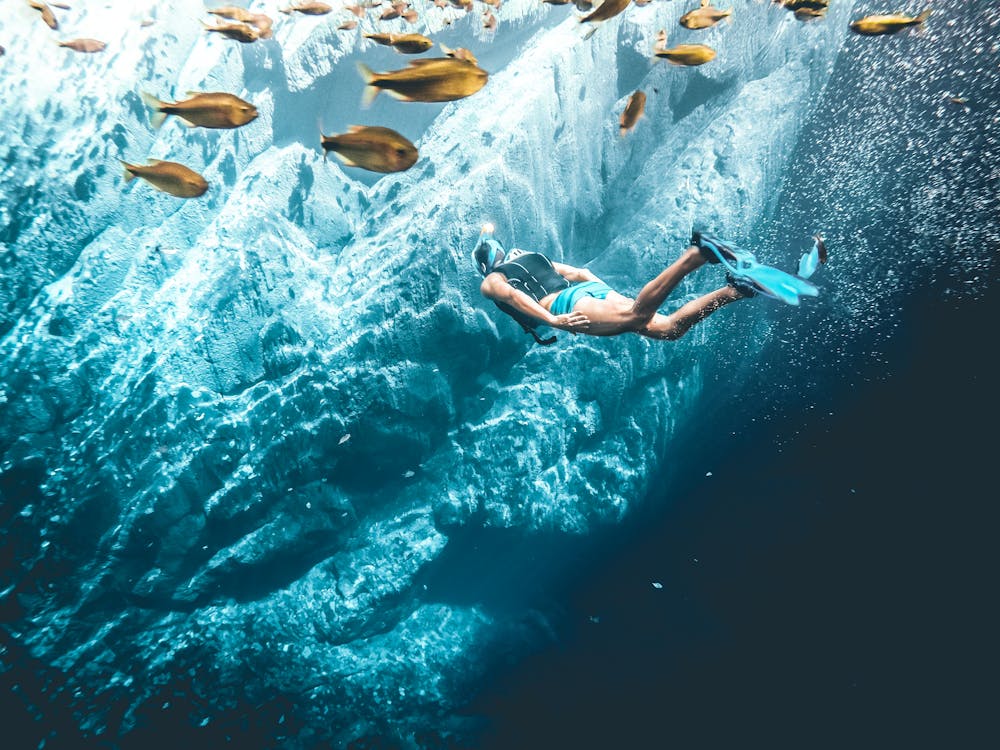
Discipline dell'apnea
L'apnea comprende diverse discipline, pensate per diversi obiettivi e capacità di profondità:
- Apnea a peso costanteIn questa disciplina i tuffatori scendono e risalgono sfruttando la propria potenza, senza l'ausilio di pesi o pinne.
- Immersione Libera Apnea:Gli appassionati si muovono lungo una linea verticale durante le discese e le risalite senza ricorrere alle pinne.
- Apnea a peso variabile:Questa disciplina consente ai subacquei di utilizzare una slitta zavorrata per la discesa e la risalita, sfruttando la loro propulsione per una parte del percorso.
- Apnea senza limiti:I subacquei utilizzano una slitta zavorrata per discese e risalite rapide, con l'ausilio di un pallone di sollevamento gonfiabile.
Quanto in profondità possono andare gli apneisti?
Le capacità di profondità di apneisti sono davvero impressionanti, consentendo loro di avventurarsi in regni sottomarini che vanno da Da 16 a 656 piediQuesta straordinaria gamma offre agli appassionati l'accesso a paesaggi incantevoli e incontri con una vasta gamma di specie marine che prosperano a profondità maggiori.
Considerazioni sulla sicurezza
Le pratiche di sicurezza responsabili sono fondamentali nell'apnea a causa delle sfide intrinseche legate all'apnea prolungata a profondità significative:
- Sistema di amici: Praticare attività di apnea con un compagno di immersione affidabile aumenta la sicurezza, offrendo supporto reciproco durante le discese e le risalite.
- Protocolli di sicurezza: Il rigoroso rispetto delle linee guida di sicurezza stabilite riduce al minimo i potenziali rischi associati alla gestione dell'ossigeno, alle difficoltà di equalizzazione e alle limitazioni fisiologiche.
- Consapevolezza ambientale:Adottare una gestione responsabile dell'ambiente è fondamentale durante le escursioni di apnea per ridurre al minimo i disturbi nei delicati ecosistemi marini a profondità maggiori.
Di quale attrezzatura subacquea ho bisogno?
L'attrezzatura utilizzata nell'apnea ha visto una crescita costante negli ultimi anni, con investimenti significativi nei progressi tecnologici da parte dei produttori di attrezzature subacquee come AvanguardiaCiò indica un aumento dei progressi tecnologici in questo settore, a dimostrazione di un crescente interesse per l'immersione tecnica e l'apnea. Oltre all'attrezzatura fondamentale come maschere, pinne, boccagli, mute, cinture con zavorra e orologi o computer subacquei comunemente utilizzati nelle attività di apnea, in genere, per l'apnea specializzata sono necessari:
Maschera a basso volume
Una maschera a basso volume progettata specificamente per l'apnea offre una migliore compensazione a profondità maggiori riducendo al minimo il volume d'aria all'interno della maschera.
Pinne a lama lunga
Le pinne a pala lunga, ottimizzate per una propulsione efficiente, consentono ai subacquei di coprire distanze maggiori con il minimo sforzo e risparmiando energia.
Snorkel aerodinamico
Uno snorkel aerodinamico riduce la resistenza durante le discese in acque più profonde, migliorando l'efficienza della respirazione e riducendo al minimo la resistenza.
Boa per apnea
Utilizzando una boa dedicata all'apnea, gli appassionati possono marcare la propria posizione in superficie durante le discese e le risalite, garantendo al contempo la visibilità al personale di supporto alla sicurezza.
Fermaglio per il naso
Una clip nasale aiuta a bilanciare la pressione nelle cavità nasali durante le discese a profondità maggiori, impedendo l'ingresso dell'acqua senza impedire la respirazione attraverso la bocca.
Pro e contro dell'apnea
Come ogni forma di esplorazione subacquea, l'apnea presenta vantaggi e considerazioni che i singoli praticanti dovrebbero valutare quando decidono di partecipare a questa disciplina.
Pro dell'apnea
1. Connessione con la natura
L'apnea consente ai subacquei di vivere il mondo sottomarino in modo più naturale e intimo, rafforzando il loro legame con la vita marina e l'ambiente.
2. Benefici fisici e mentali
L'apnea migliora la forma fisica, il controllo del respiro e le tecniche di rilassamento, migliorando la capacità polmonare e riducendo i livelli di stress.
3. Soluzione conveniente
Rispetto alle immersioni subacquee, l'apnea richiede un'attrezzatura minima, il che la rende un'opzione più economica per l'esplorazione subacquea.
4. Senso di realizzazione
Completare un'immersione in apnea a profondità o durate maggiori può dare un senso di realizzazione e di crescita personale.
Contro dell'apnea
1. Rischio di blackout
L'apnea comporta il rischio di ipossia e di perdita di coscienza in acque poco profonde, che possono portare alla perdita di conoscenza sott'acqua.
2. Lesioni da pressione
Gli apneisti sono soggetti a barotrauma e malattia da decompressione quando si immergono a profondità considerevoli senza la formazione e le precauzioni adeguate.
3. Esigenze fisiche
L'apnea richiede una buona forma fisica, capacità di trattenere il respiro e disciplina mentale, il che può risultare impegnativo per alcuni individui.
4. Rischi ambientali
Gli apneisti devono essere consapevoli dei potenziali pericoli presenti nell'ambiente sottomarino, come l'incontro con la vita marina, le forti correnti e le condizioni mutevoli.
La differenza tra snorkeling, immersioni in apnea e apnea
Quando si parla di attività subacquee, lo snorkeling, l'immersione subacquea e l'apnea offrono esperienze uniche e presentano differenze sostanziali in termini di attrezzatura, profondità raggiungibili e tecniche di respirazione.
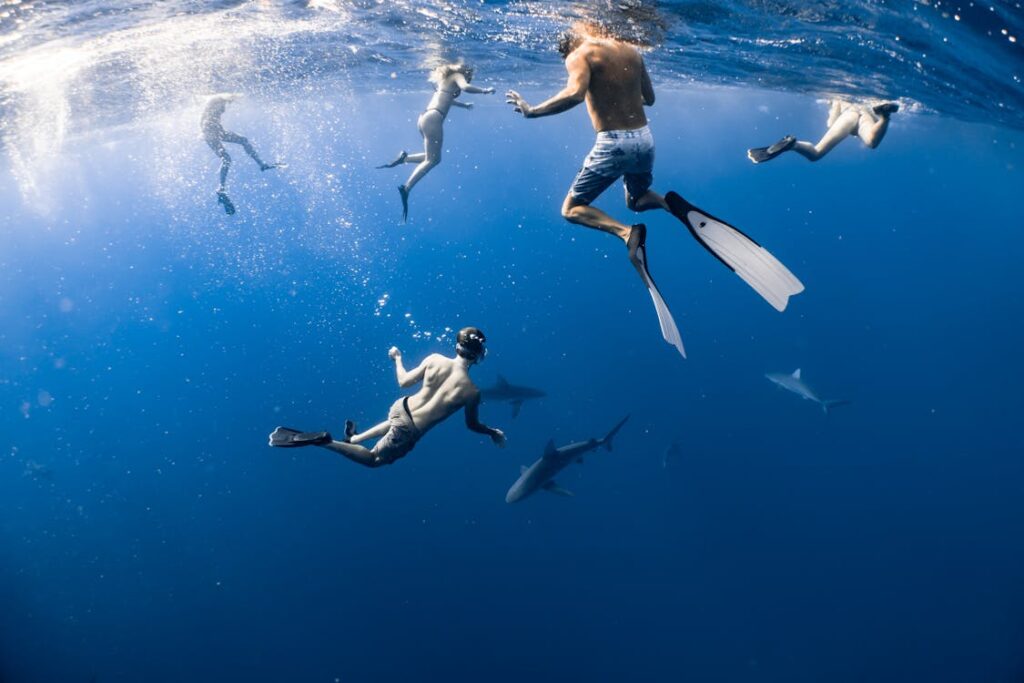
Variazione dell'attrezzatura
Snorkeling In genere richiede un'attrezzatura minima, tra cui una maschera per una visione chiara sott'acqua, uno snorkel per respirare in superficie e pinne per la propulsione. Questa forma accessibile di esplorazione subacquea attrae chi cerca incontri rilassati con la vita marina in acque poco profonde.
D'altra parte, immersioni subacquee Prevede l'utilizzo di attrezzature simili allo snorkeling, ma consente ai sub di scendere sotto la superficie dell'acqua. Gli appassionati possono anche optare per attrezzature aggiuntive come mute o rash guard per garantire protezione termica e controllo dell'assetto a diverse profondità.
Al contrario, apnea Richiede attrezzature specializzate, studiate su misura per migliorare le prestazioni a profondità maggiori. Tra queste, maschere a basso volume progettate per una migliore compensazione in profondità, pinne a pala lunga ottimizzate per una propulsione efficiente, snorkel aerodinamici che riducono al minimo la resistenza durante le discese e boe dedicate per l'apnea per segnare la posizione in superficie durante le risalite.
Capacità di profondità e durata
Le profondità a cui queste attività subacquee possono raggiungere variano notevolmente.
| Attività | Profondità media (piedi) | Profondità massima (piedi) | Durata media (minuti) | Durata massima (minuti) |
| Snorkeling | 3-10 | 20 | 30-60 | 120 |
| Immersioni in apnea | 16-131 | 150 | 30 | 60 |
| Apnea | 330+ | 330+ | 2-5 | 10+ |
Tecniche di respirazione e differenze di equipaggiamento
Le tecniche di respirazione svolgono un ruolo fondamentale nel distinguere queste attività subacquee. amanti dello snorkeling affidarsi a uno snorkel per respirazione efficiente sulla superficie dell'acqua galleggiando senza sforzo sopra acque poco profonde. L'uso di uno snorkel limita la profondità di immersione, ma offre un mezzo accessibile per osservare gli ecosistemi marini senza una formazione specifica o attrezzature specializzate.
Al contrario, entrambi subacquei E apneisti Utilizzare tecniche di apnea che consentono loro di scendere sotto la superficie dell'acqua senza dover ricorrere a bombole di aria compressa o ad autorespiratori, come avviene nelle immersioni subacquee. Tuttavia, gli apneisti seguono un rigoroso addestramento sulle corrette tecniche di respirazione e sugli adattamenti fisiologici essenziali per trattenere il respiro a profondità significative, rispetto alle discese relativamente più superficiali degli apneisti.
Conclusione
In conclusione, sebbene snorkeling, apnea e apnea implichino tutte l'esplorazione di ambienti sottomarini, differiscono significativamente nelle tecniche, nell'attrezzatura e nelle profondità. Lo snorkeling consente l'osservazione in superficie con un boccaglio, l'apnea prevede immersioni poco profonde senza autorespiratore e l'apnea si immerge in profondità utilizzando tecniche di apnea. Spero che questa guida completa sulle differenze tra snorkeling, apnea e apnea consenta agli appassionati di scegliere l'esperienza più adatta alle proprie preferenze e al proprio livello di abilità per l'esplorazione subacquea.
Domande frequenti
1. Qual è la differenza tra immersioni subacquee e snorkeling?
Lo snorkeling in genere consiste nel galleggiare sulla superficie dell'acqua respirando attraverso un boccaglio, permettendo ai partecipanti di osservare la vita sottomarina senza immergersi in profondità. Al contrario, l'apnea subacquea consiste nell'immergersi sott'acqua senza l'ausilio di un autorespiratore, affidandosi esclusivamente alla ritenzione del respiro, spesso per brevi periodi, per esplorare ambienti sottomarini più profondi.
2. Qual è la differenza tra snorkeling e apnea?
Lo snorkeling e l'apnea sono entrambe attività acquatiche, ma variano significativamente in termini di profondità, durata e utilizzo dell'attrezzatura. Lo snorkeling consiste nel galleggiare sulla superficie dell'acqua con un boccaglio, consentendo la respirazione continua durante l'osservazione della vita sottomarina. Al contrario, l'apnea consiste nell'immergersi sott'acqua senza attrezzatura, trattenendo il respiro per periodi prolungati per esplorare profondità maggiori. L'apnea richiede un addestramento specializzato per le tecniche di apnea e i protocolli di sicurezza, consentendo ai subacquei di scendere a profondità maggiori per periodi più brevi rispetto allo snorkeling.
3. Qual è la differenza tra immersioni subacquee e apnea?
La principale differenza tra immersioni subacquee e apnea risiede nel loro approccio all'esplorazione subacquea e nell'uso dell'attrezzatura. Le immersioni subacquee, spesso chiamate immersioni con autorespiratore, prevedono l'uso di attrezzature specializzate come bombole, erogatori e dispositivi di controllo dell'assetto per respirare sott'acqua ed esplorare profondità maggiori per periodi prolungati. D'altra parte, l'apnea è una forma di immersione subacquea che si basa esclusivamente su tecniche di apnea, senza l'uso di autorespiratori. Gli apneisti scendono a diverse profondità utilizzando solo la loro capacità polmonare, il che richiede un addestramento specifico in apnea e protocolli di sicurezza.
4. Lo snorkeling è più difficile delle immersioni?
Lo snorkeling è generalmente considerato più facile delle immersioni perché richiede meno attrezzatura specializzata e meno addestramento. Chi pratica lo snorkeling rimane in superficie, respirando attraverso un boccaglio, mentre i subacquei utilizzano l'attrezzatura subacquea per esplorare profondità maggiori. Le immersioni richiedono maggiori competenze tecniche e conoscenze di sicurezza.
5. Indossi lo snorkel quando fai apnea?
Nell'apnea, lo snorkel viene solitamente utilizzato durante gli intervalli di superficie per respirare mentre si galleggia in superficie. Tuttavia, una volta iniziata la discesa sott'acqua, l'apneista non utilizza lo snorkel, poiché può creare una resistenza inutile e ostacolare l'efficienza dei movimenti in acqua. Gli apneisti si affidano esclusivamente alla loro capacità di trattenere il respiro durante l'esplorazione subacquea.
